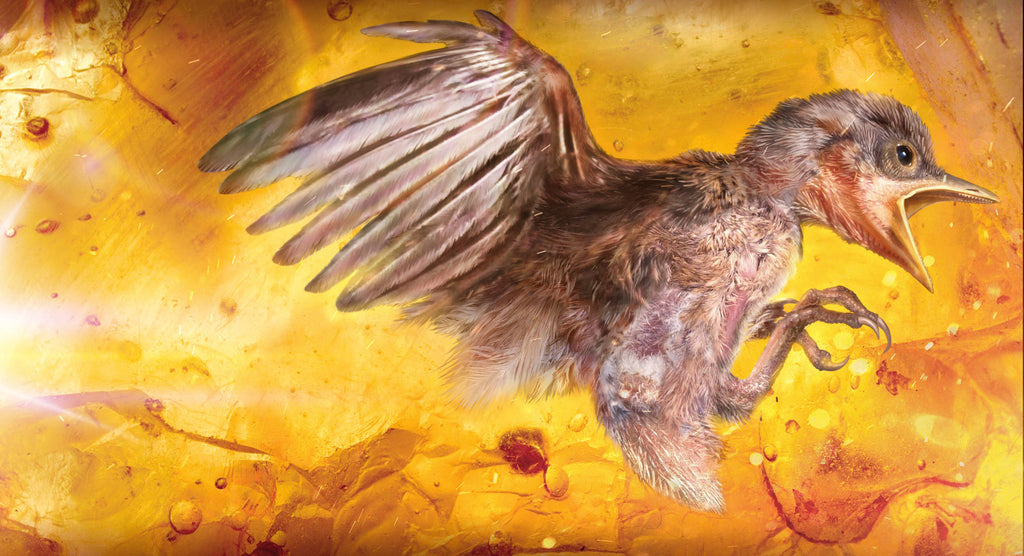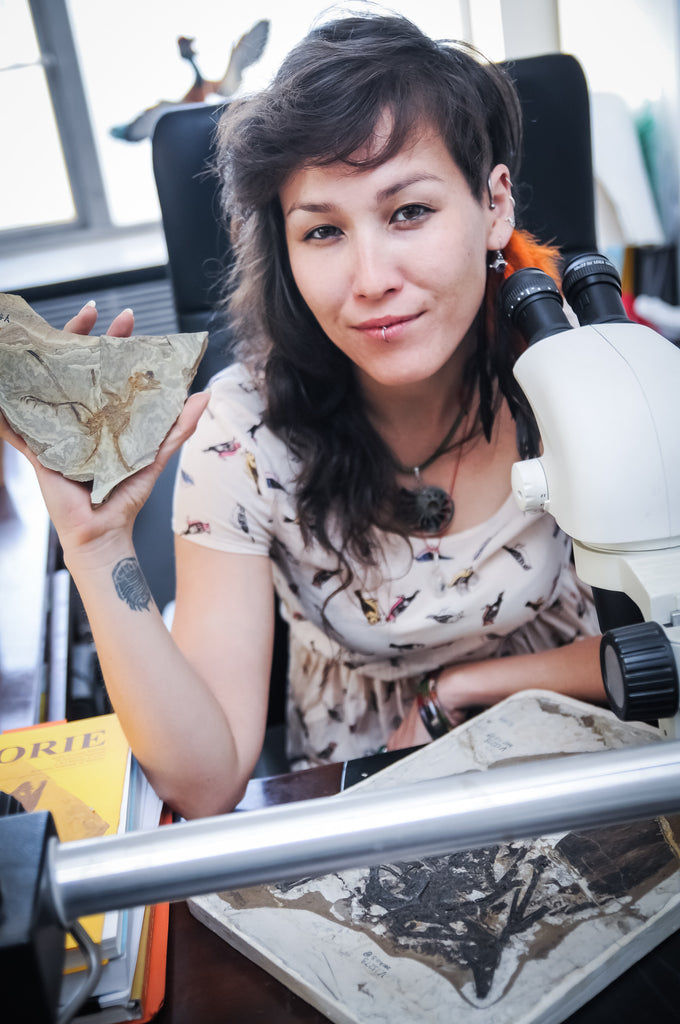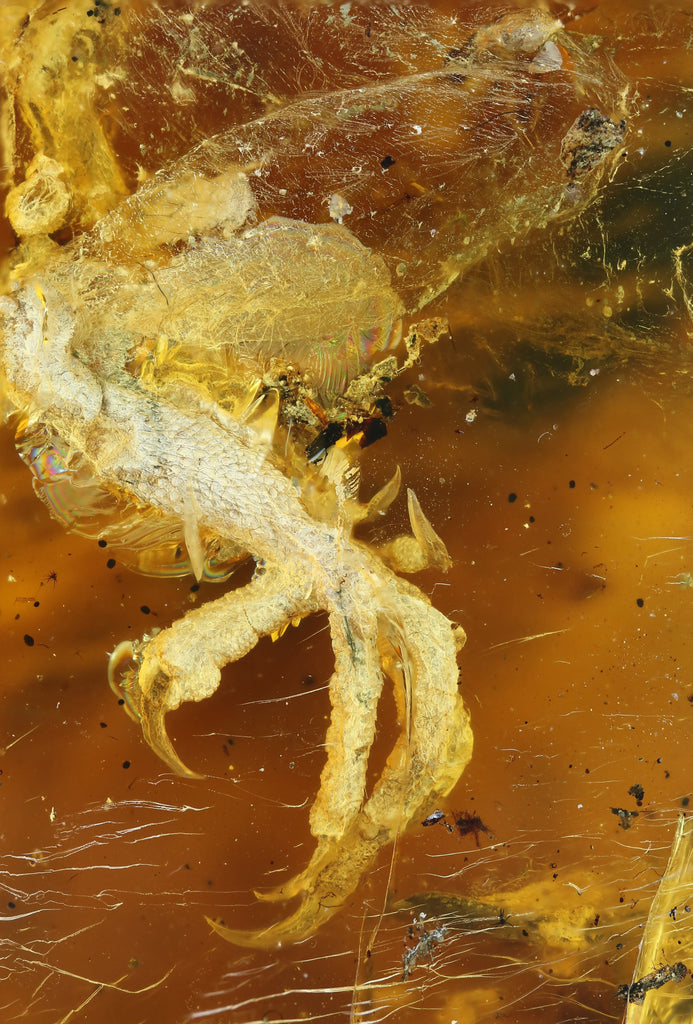Baby bird found in Burmese amber: Q&A with Dr. Ryan McKellar
by Peter Lovisek, CEO of Fossil Realm
 Artist's reconstruction, based on preserved material and knowledge of Enantiornithes fossils, compared to the x-ray micro-CT data. Credit: Ming Bai, Chinese Academy of Sciences (CAS)
Artist's reconstruction, based on preserved material and knowledge of Enantiornithes fossils, compared to the x-ray micro-CT data. Credit: Ming Bai, Chinese Academy of Sciences (CAS)
The shocking discovery of a Cretaceous toothed bird preserved in Burmese amber has made headlines around the world. The 99-million year old hatchling is the best-preserved specimen of its kind: features such as eyelids, ear openings and even feather pigmentation remain. The specimen expands our understanding of early feathers and sheds light on the anatomy, development and lifestyle of a major group of Mesozoic birds, the Enantiornithes, which lived alongside the dinosaurs. The paper was published in Gondwana Research and is available online.
We were privileged to hear more about this monumental discovery from key team member, Dr. Ryan McKellar, Curator of Invertebrate Palaeontology at the Royal Saskatchewan Museum. Dr. McKellar also participated in the study of the first feathered dinosaur tail in amber, found in the same region of Myanmar (Burma).
What is your reaction to the extensive coverage that this story is receiving?
It is fantastic to see public interest in palaeontology expanding to encompass this unusual new line of research. Hopefully these little glimpses of ancient ecosystems and their inhabitants will add more to the fossil record of vertebrates within the coming years.
What was your role in this project?
The project was led by Lida Xing, and I helped out with the study of the feathers and some of the work on taphonomy (i.e., preservation and how the animal entered the resin).

You also have a background in invertebrate palaeontology. Did this experience help inform the study of this vertebrate find?
Yes, to some extent – we looked for things like insect and mite inclusions that could tell us if the specimen had been scavenged, or if it hosted parasites while it was alive.
Did you discern whether or not this bird was scavenged or parasitized?
There were no signs of struggle, so we think that this specimen may have been dead before it hit the resin. Aside from one femur being dragged out of its natural position, there were not any clear signs that the specimen had been scavenged or parasitized.
This was an international project that also included scientists from the United States and China. Were you the only Canadian involved?
Yes, but I was lucky to have colleagues at the RSM (Royal Saskatchewan Museum) that were able to provide access to modern bird hatchlings for comparison.
Were there any challenges working in Myanmar?
Lida has done most of the fieldwork in this area, and many of the specimens that we study come from amber markets. In the case of this specimen, it was purchased by the Hupoge Amber Museum in China, and they contacted Lida to study the specimen when they realized the connection between the specimen and his research. The mining region itself is in the Kachin State of northern Myanmar, which can be a turbulent area.
 Amber mine site in the Kachin State of Myanmar. Credit: Huabao Dong
Amber mine site in the Kachin State of Myanmar. Credit: Huabao Dong
Invertebrates or plant material are common amber inclusions, whereas vertebrates are rarely found in amber. Why are vertebrates found in amber from this locality?
The amber from Myanmar is harder and generally has larger sized pieces than other Cretaceous amber deposits. This may be due to production by a unique kind of conifer, or under special conditions that produced large volumes of resin, such as forest flooding or tree diseases. It is mined on a massive scale, which means that many more pieces are available for study than any other Cretaceous deposit.
What are the advantages and disadvantages to studying fossils found in amber compared to typical forms of preservation?
The advantages of studying fossils in amber include being able to see specimens in greater detail, with microscopic structures, traces of original colours, and remnants of soft tissues that are unlikely to preserve in other settings. Beyond this, seeing specimens in three-dimensions, and surrounded by other fossils within the amber sometimes gives ecological clues or preserves frozen behaviours that we find nowhere else. Unfortunately, amber only preserves small animals or fragments of larger animals, which can make it hard to get the bigger picture. Often the specimens are sealed deep within the amber, limiting our ability to observe their chemistry.
Did the study of the theropod dinosaur in amber inform or aid the study of this bird?
As with many types of research, having a large sample size and good comparison material is key to studying this material. Each of the specimens that we have worked on in the past, as well as the published work of others, helps to build our understanding. The dinosaur tail in Burmese amber (as well as some of the “protofeathers” trapped in Canadian Cretaceous amber, and a wide range of compression fossils with feather traces) helped to shape our expectations about certain feather types being more ‘dinosaur-like’ or more similar to those of modern birds.
The work by Jingmai O’Connor and Luis Chiappe on the skeletal material also benefited from a larger range of Enantiornithines preserved in sedimentary rocks.
 Jingmai in her lab, with a fossil bird. Credit: Jingmai O'Connor, Chinese Academy of Sciences (CAS, IVPP)
Jingmai in her lab, with a fossil bird. Credit: Jingmai O'Connor, Chinese Academy of Sciences (CAS, IVPP)
This specimen has eyelids, pigment, scales and other detailed tissue preservation. It's also quite complete. How remarkable is this level of preservation?
In terms of the whole fossil record for enantiornithes, there have been specimens recovered from sedimentary rocks with a greater part of the skeleton preserved, but in these specimens the feathers are usually compacted into a thin film of carbon with limited surface detail. We described a pair of wing tips from enantiornithines in Burmese amber last year, but this is the first time that we get to see a large part of the skeleton (head, neck, two feet, and a wing tip), plus a layer of feathers and translucent skin that represents most of the right side of the body.
Can you elaborate on the translucent sheets of skin found on the CT scan? What is the significance of this tissue? Was this a shocking find?
When we started trying to map out the feathers on the preserved body parts that showed up in the CT scan, we realized that there were ghost-like traces of the skin from the lower leg present, and that if we examined the specimen hard enough under a wide range of lighting conditions and overlaid the CT scan data, we could actually map out the skin surface for most of the right side of the body. The significance of this tissue is that it gives us a first glimpse of feathers across almost the entire body, which is something that we do not really get with more typical compression fossils.
The skin sheets were a bit shocking, because we had been debating whether the individual skeletal components in the amber could all belong to the same individual, and if there was any traces of predation or scavenging. Once we realized that there was a big difference in visible preservation between the regions that preserved bone and those that only had skin and feathers preserved, it quickly became obvious that we had most of a single individual, including parts like the tail, where the bones had been weathered away.
 Graphical abstract for Gondwana Research, highlighting connection between specimen in amber, x-ray micro-CT data, and the whole-body artist's reconstruction. Credit: Jingmai O'Connor, Chinese Academy of Sciences (CAS, IVPP), with components from Chung-Tat Cheung and Ming Bai.
Graphical abstract for Gondwana Research, highlighting connection between specimen in amber, x-ray micro-CT data, and the whole-body artist's reconstruction. Credit: Jingmai O'Connor, Chinese Academy of Sciences (CAS, IVPP), with components from Chung-Tat Cheung and Ming Bai.

Overview of foot and shin, showing translucent skin preserved above ankle region. Credit: Ming Bai, Chinese Academy of Sciences (CAS)
Does this discovery change our understanding of the evolution of feathers? Does it have any bearing on our understanding of the evolution of birds?
This specimen shows that enantiornithines had flight feathers that were similar to those of modern birds, but that hatchlings retained a sparse coat of bristles among the feathers on the feet, legs, and tail that are superficially similar to the “protofeathers” that have been found around dinosaur skeletons. This may mean that primitive feather types can be studied from juveniles across a wider range of evolutionary groups.
What's the most unique or surprising feature of this bird's plumage?
The presence of bristles among the feathers on the legs and tail suggest that there may have been some evolutionary holdovers in this group of birds, and finding sheathed feathers at the tip of the tail gave a remarkably narrow time span since the bird had hatched.
Can you briefly explain the difference between dinosaur feathers, ancient bird feathers and modern bird feathers?
In a nutshell, many theropod dinosaurs simple feathers that take the form of isolated bristles, or display simple branching patterns. As you get closer to modern birds in an evolutionary sense, the feathers develop complex branching patterns and become the flattened, asymmetrical, vaned feathers that we associate with modern birds.
 Overview of wing tip (finger bones preserved in lower left corner of image), showing how feathers attach to wing bones. Credit: Ming Bai, Chinese Academy of Sciences (CAS)
Overview of wing tip (finger bones preserved in lower left corner of image), showing how feathers attach to wing bones. Credit: Ming Bai, Chinese Academy of Sciences (CAS)

Illustration of feather distribution and preserved skin outline. Credit: Royal Saskatchewan Museum (RSM/ R.C. McKellar)
Can you explain how Cretaceous birds differ from modern birds?
The biggest differences between the birds that we were studying and modern birds are the presence of teeth, claws on the wings, and a different arrangement of bones in the shoulder and ankle regions.
What was the biggest developmental difference in these prehistoric birds compared to modern birds?
The enantiornithines were highly precocial, meaning that they hatched on the ground with little parental care and a full set of flight feathers on their wings, then took to the trees shortly after hatching. This developmental pattern still exists in some birds, such as the Brush Turkey, but most modern birds are much more reliant on their parents.
Were there any advantages of this situation compared to dependency? Were there any disadvantages?
The advantages for the parent would have been energy saved without the need to tend the nest or feed the hatchlings until they had developed to the point of being able to fend for themselves. The disadvantage would have been higher mortality among the hatchlings – this is probably part of the reason that we have such a good fossil record for juvenile enantiornithines – many of them died young.
Lastly, will there be any further analysis of the fossil?
Although most of this specimen is deeply buried within the amber mass, it is hoped that we might be able to take a closer look at the colours that are preserved, and how accurately the visible traces of colour reflect what the animal would have looked like when it was alive.


Comments
Gord Campbell said:
I was wondering… Any chance of retrieving any Mitochondrial DNA from the sample?
Peter Lovisek said:
Amber this old does not contain DNA that can be retrieved in a useful way.
Seumas MacLaren said:
Peter, Will you be sequencing the proteins, and will you submit any portion of the sample to an AMS carbon/nitrogen analysis?
Peter Lovisek said:
Hi Seumas, for details like this I’d recommend contacting one of the researchers – Ryan McKellar, Lida Xing, Jingmai O’Connor or Luis M. Chiappe (I only reported the story).
Eldon Grupp said:
Looks like Lianiornis delicatus.
Eldon Grupp said:
Looks like Lianiornis delicatus.